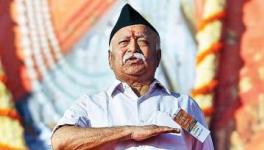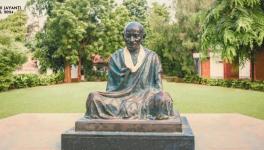Decoding Modi’s Statement on Muslim League ‘Imprint’ on Congress Manifesto

Syama Prasad Mookerjee of Hindu Mahasabha and M A Jinnah of Muslim League.
Image Credit: Sabrang India
Prime Minister Narendra Modi’s recent statement that the Congress party’s election manifesto for the 2024 general elections bears the stamp of Muslim League of pre-independence India is riddled with prejudices flowing from his wilfuly flawed understanding of the contents of the manifesto, which are historic. There is nothing in it that is remotely connected with the Muslim League that was headed by Muhammad Ali Jinnah prior to India’s independence.
In fact, the contents of the manifesto which, among others. included conduct of caste census across the country, reservation for women in jobs, legislation to implement minimum support price for crops, removing 50% ceiling on reservation and providing reservation in the private sector have nothing to do with the perspectives of Muslim League that existed in the pre-independence era. So far, no reasonable explanation has been put forward to justify the Prime Minister’s absurd assertions.
Muslim League and Hindu Mahasabha Complemented Each Other
A peep into history reveals that our leadership during the freedom struggle put Muslim League and Hindu Mahasabha on the same footing and educated the public by their articulations that neither was interested in the freedom of India from British rule.
Mahatma Gandhi, while in Bardoli, issued a statement to the press on December 27, 1941, wherein he described the Hindu Mahasabha as a sister organisation of the Muslim League. He did so when the president of the Hindu Mahasabha, V D Savarkar, along with B S Moonje, known for their support for colonial rule and the British government’s decision to drag India to join the Second World War, were arrested in Bihar. This was after the Hindu Mahasabha was barred from holding its meeting to avoid the possibility of a communal clash at the time of Bakri-id. Gandhi, while condemning the arrest and denial of freedom to hold that meeting, said in that press statement that “the Muslim League could not possibly wish the denial to their sister organisation of a liberty which they could claim for themselves.”
While Gandhi stated that Muslim League was the “sister organisation” of Hindu Mahasabha, Netaji Subhash Chandra Bose, in his book, Indian Struggle:1920-1942, expressed disappointment with the two organisations, as their leaders -- Jinnah of the Muslim League and Savarkar representing Hindu Mahasabha -- never joined the united struggle of Indians for the freedom of the country. Netaji wrote before leaving India incognito that “…nothing could be expected from either the Muslim League or the Hindu Mahasabha."
So, when Prime Minister Modi says that the Congress manifesto in 2024 has the imprint of Muslim League of the pre-independence era, he, by the logic employed by Gandhi and Netaji, is also seeing the impact of Hindu Mahasabha on it.
Hindu Mahasabha Formed Coalition Govt with Muslim League
The complementarity of Muslim League and Hindu Mahasabha was best expressed in 1941 when Syama Prasad Mookerjee, an influential figure of the Hindu Mahasabha, joined the Fazlul Haq ministry in Bengal, as its finance minister. That coalition of Hindu Mahasabha and Muslim League testified to the fact that both were sister organisations.
It is worthwhile to recall that Fazlul Haq, as part of Muslim League, moved the divisive resolution, known as the ‘Pakistan Resolution’, which affirmed the League’s intent to divide India and create a separate Muslim nation. The Congress then had condemned Haq as a rank communalist.
Apart from Bengal, the Hindu Mahasabha also joined the Muslim League to form coalition governments in the Sind and the North-West Frontier Province.
On March 3, 1943, when the resolution of G.M. Syed of Muslim League was passed in the Sind legislative assembly to the effect that “Muslims of India are a separate nation”, the Hindu Mahasabha leaders, who were part of the coalition government, opposed it but did not quit the government.
These historical records clearly show that the Muslim League which Modi is referring to in the context of the Congress manifesto, was in hand-in-glove with the Hindu Mahasabha for the sake of forming the government and sharing power in the early 1940s.
Modi’s Statement Aimed at Polarising Electorate
Now, in 2024, Modi is curiously discovering the ‘imprint’ of Muslim League in Congress manifesto. It is indeed beyond comprehension to see any link between the Muslim League of pre-independence period and the Congress manifesto. Prime Minister Modi has not explained the reasoning behind the link that he has drawn. Modi, who extols Syama Prasad Mookerjee as the founder of Jan Sangh, which preceded Bharatiya Janata Party as a political outfit, should recall Mookerjee’s statement of December 17, 1946 in the Constituent Assembly. While participating in the discussion on the Objectives Resolution in the Constituent Assembly on that date, Mookerjee described the Moghul rulers as ‘great’ rulers and charged the Britishers of coming as supplicants to their courts and damaging India by their many acts of omission and commission, which, among others, was mixing religion with politics.
Paradoxically, Modi is now juxtaposing the contents of the Congress election manifesto with the thinking of the then Muslim League, and at the same time is mixing religion with politics with many of his actions and articulations. In doing so, he is playing out Mookerjee’s charge against the Britishers of introducing religion to politics.
Therefore, in saying that the “thinking” of Muslim League of pre-independent India is writ large in the Congress manifesto, Modi is mixing his prejudices against Muslims with a political document, thereby consolidating the polarisation process to garner electoral dividends.
The writer served as Officer on Special Duty to President of India, K R Narayanan. The views are personal.
Get the latest reports & analysis with people's perspective on Protests, movements & deep analytical videos, discussions of the current affairs in your Telegram app. Subscribe to NewsClick's Telegram channel & get Real-Time updates on stories, as they get published on our website.
























